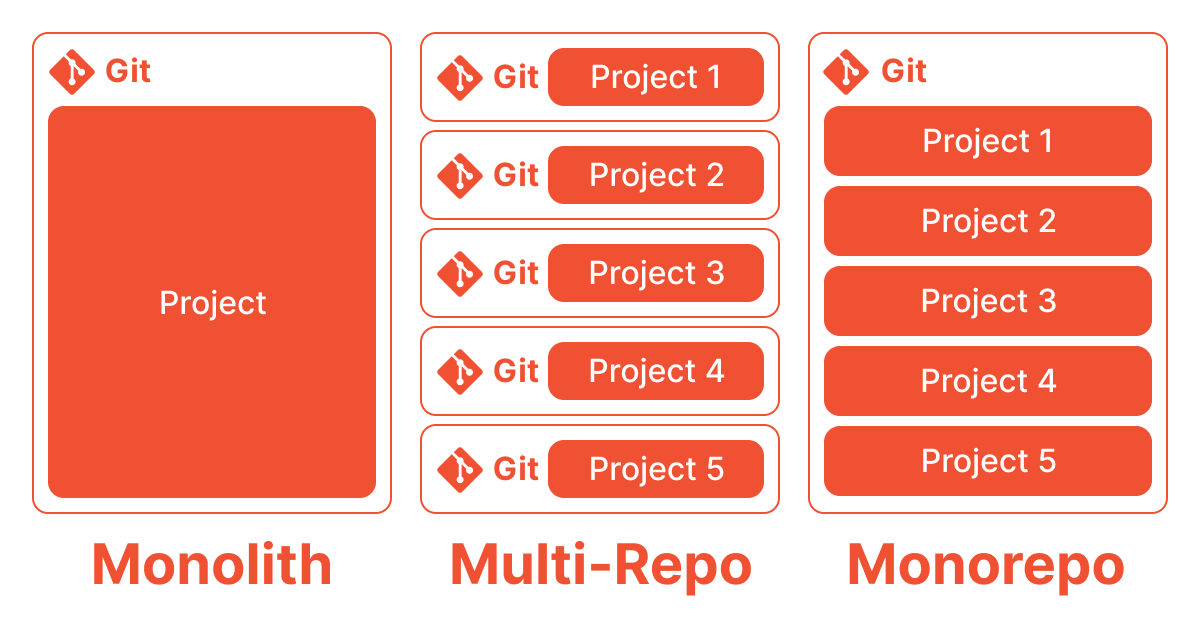Outline
When developing a project, you will decide whether to use a single repository or multiple repositories. In this blog post, I will introduce repository strategies for managing projects, such as Monolith, Multi Repo, and Monorepo.
Blog Series
This blog is a series. You can check other blog posts through the following links.
- [Project Management] Repository Strategy
- [JavaScript] Tools for Monorepo
- [Monorepo] Node JS module resolution
- [Monorepo] Symlink
- [Monoepo] Yarn Workspaces
- [Monoepo] Dependency Hoisting of Yarn Workspaces
- [Monoepo] Command of Yarn Workspaces
- [Monoepo] Creating a Monorepo with PnPM
Repository Strategy
There are Monolith, Multi Repo, and Monorepo as repository strategies like the following.

- Monolith: Monolith is creating a single service as a single project and managing it as a single repository.
- Multi Repo: Multi Repo is dividing a single service into multiple projects and managing them in multiple repositories.
- Monorepo: Monorepo is dividing a single service into multiple projects and managing them as a single repository.
Monolith
Monolith is a project management technique that designs software projects as a single codebase and a single application. In the monolith architecture, all components of the application are integrated into a single codebase and developed, deployed, and operated.
Advantages of Monolith
- Easy management and maintenance: Since it is composed of a single codebase, overall management and maintenance are relatively easy.
- Easy integration testing: Since the entire system is composed of a single application, integration testing is easy.
- Improved initial development speed: At first, everything is in one place, so development can proceed quickly.
Disadvantages of Monolith
- Scalability constraints: As the size of the application increases, scalability may become difficult.
- Technology stack dependency: Since it depends on a single technology stack, it may be difficult to introduce various technologies.
- Difficulty of deployment: Since the entire application needs to be modified and deployed, it may be difficult to deploy small changes.
Considerations when introducing Monolith
In the following cases, you can consider introducing Monolith.
- Small-scale project: If it is a small project, you can increase the initial development speed.
- If easy maintenance is required: For simple applications, maintenance may be easier.
- If the technology stack is clear: If a clear decision has been made on a specific technology stack, Monolith may be useful.
- If the team is small: If a small team is collaborating and developing, Monolith may be effective.
However, as the size and requirements of the project increase, you need to consider other architectures such as distributed architecture or microservice architecture. This can increase the scalability, flexibility, and independence of the application.
Multi Repo
Multi Repo is a project management technique that develops software projects in multiple independent repositories. Each repository corresponds to a specific feature, module, or service, and development. Each repository is managed separately for deployment and operation.
Advantages of Multi Repo
- Independent development and deployment: Each repository can be developed, tested, and deployed independently, allowing for faster development cycles.
- Scalability: If the load of a specific module or service increases, only that repository can be scaled to improve the overall performance of the system.
- Technology stack diversity: Each repository can choose an independent technology stack, so you can use multiple technologies without relying on a specific technology.
- Separated codebase: Each repository can focus on a specific feature or business area, improving code readability and maintainability.
Disadvantages of Multi Repo
- Difficulty in dependency management: It can be complicated to manage dependencies between various repositories.
- Difficulty in overall system integration: Each repository is developed independently, and conflicts may occur when integrating them, which may take time to resolve.
- Lack of comprehensive vision: It may be difficult to understand and manage the entire system, especially when an integrated vision is required.
Considerations when introducing Multi Repo
In the following cases, you can consider introducing Multi Repo.
- Large-scale project: If the project is large and contains various features or modules, you can manage each of them independently.
- Collaboration between teams: If multiple teams are working at the same time and want to develop independently, Multi Repo may be effective.
- Service-oriented architecture (SOA) or microservice architecture: Multi Repo is useful for managing each service independently, which fits well with SOA or microservice architecture.
Multi Repo is suitable for supporting team collaboration and fast development cycles in a distributed environment. Especially in service-oriented architecture, it is important to manage each service separately.
However, if the team size is small or the project size is small, too many technology stacks and difficulty in repository management may occur.
Monorepo
Monorepo is a project management technique that designs software projects as a single large codebase and develops them as a single repository. In this method, all source code, libraries, and modules are stored and managed in one central location.
Advantages of Monorepo
- Easy dependency management: Since all dependencies are managed in one codebase, dependency conflicts and version management are easy.
- Easy to understand the entire system: It is easy to understand the overall structure and operation of the project. The entire system can be seen at a glance.
- Code reusability: Since all modules and libraries are in one repository, code reusability is easy.
- Easy integration testing: Integration testing for the entire system can be easily performed.
Disadvantages of Monorepo
- Difficulty in managing large-scale projects: As the size of the project increases, the build time increases, and collaboration between teams on all code may become difficult.
- Technology stack dependency: Since all code is in one repository, you may be constrained by a specific technology stack.
- Performance degradation of CI/CD: In a large-scale Monorepo, continuous integration and deployment performance may be degraded.
Considerations when introducing Monorepo
In the following cases, you can consider introducing Monorepo.
- Small-scale project: If the project is small, it may be convenient to manage it in one repository.
- Collaboration between teams: If all teams work in one repository, code sharing and collaboration are easy.
- If dependency management is important: When dependencies are complicatedly intertwined within the project, Monorepo is easy to manage.
- If a single technology stack is required: When a specific technology stack needs to be used consistently, Monorepo may be suitable.
Monorepo is especially useful for small-scale projects or team collaboration is required, and it can be effective when a specific technology stack needs to be unified. However, as the size and complexity of the project increase, the limitations of Monorepo may appear.
Completed
Done! we’ve seen the repository strategies like Monolith, Multi Repo, and Monorepo for managing projects. There is no good or bad strategy. You can choose the appropriate strategy according to the size and requirements of your project.
Was my blog helpful? Please leave a comment at the bottom. it will be a great help to me!
App promotion
Deku.Deku created the applications with Flutter.If you have interested, please try to download them for free.




